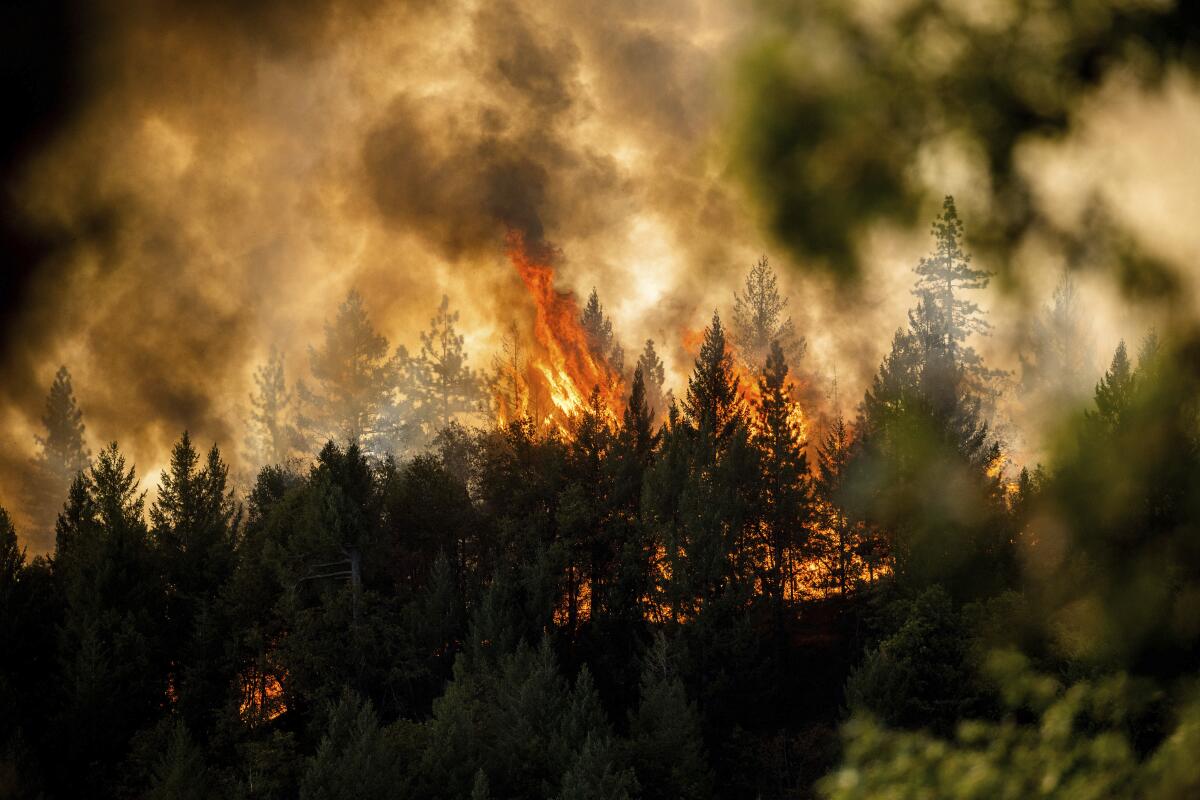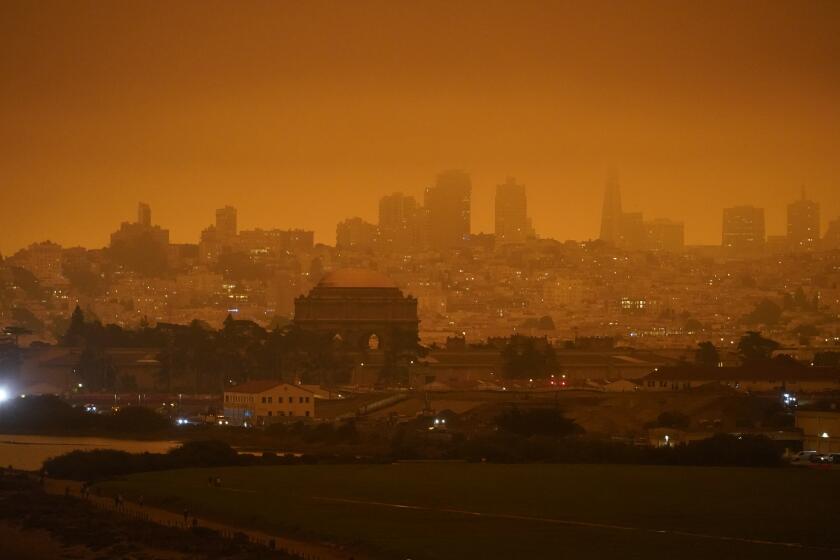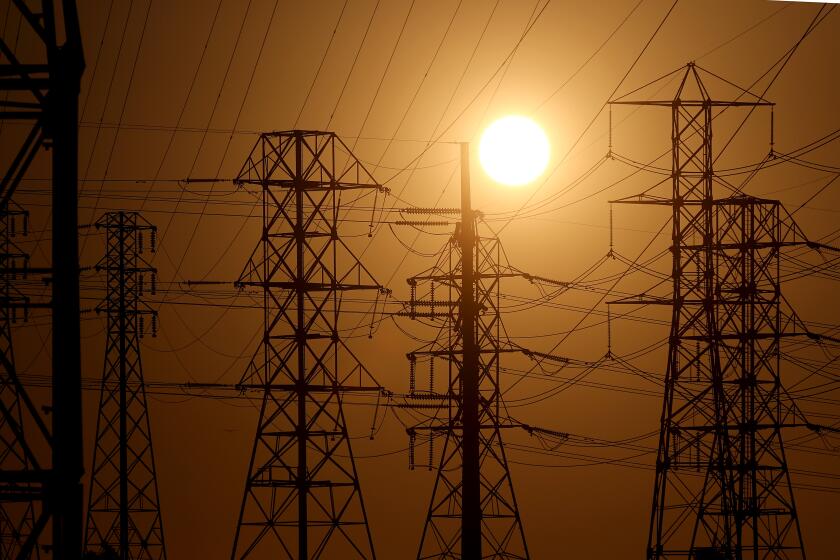Weekend storms could be a mixed blessing for crews battling Californiaâs largest wildfire

Firefighters battling the Mosquito fire, Californiaâs largest blaze this year, were up against treacherous terrain and critically dry fuels Thursday, but a storm system expected to move through the area over the weekend could bring welcome moisture.
As of Thursday night, the blaze had charred 67,669 acres in El Dorado and Placer counties and was 20% contained, according to the California Department of Forestry and Fire Protection.
Officials said the coming storm, which was moving toward the West Coast from the Gulf of Alaska, will be a mixed blessing for firefighting efforts.
Winds will pick up starting Saturday, when temperatures will fall and humidity levels will rise, Jonathan Pangburn, a fire behavior analyst, said during a Thursday night community meeting. Higher winds could throw embers ahead of the blaze, sparking spot fires.
âOn the other hand, of course, the moisture is a welcome relief for all of us in drought-stricken California,â he said.
By Sunday morning, the area could see rain, possibly lasting through Tuesday or Wednesday. The most recent forecasts available Thursday night showed an 80% chance of one-quarter inch of rain and about a 50% chance of âpossibly greater than an inch,â Pangburn said.
âBut that is of course over multiple days, so a little bit of showers here and then a break, and then a little bit of showers again, so itâs not all one, large rain event,â he said.
The blaze continued to grow Thursday, but fire behavior was moderated Thursday morning and into the afternoon by rebounding humidity levels and a thick layer of smoke that shaded the east side of the fire, Cal Fire officials said.
âFirefighters focused on securing the west corner of the fire down in the Middle Fork of the American River below the communities of Todd Valley and Foresthill,â according to Cal Fire. âCrews are finishing the last remaining portions of firing operations along the control lines that tie into the river.â
The fire continued its steady growth to the east, where âcritically dryâ vegetation is fueling the spread, officials said.
Crews worked with dozers and heavy equipment to build control lines âin steep and rugged terrain,â according to Cal Fire.
Firefighters also continued to mop up hot spots and patrol the blazeâs southern edge along Volcanoville Road.
âCooperators and utility companies continue work in these areas to assess and start needed infrastructure repair with the goal of repopulating the communities as soon as it becomes safe to do so,â according to Cal Fire.
More than 9,000 homes and structures remain threatened by the flames, and 70 have already been destroyed. There were 11,277 people evacuated as of Thursday night.
Fire officials urged those who have evacuated to be patient.
âIt is one of our top concerns to get each and every one of you back into your residence, and we are having meetings daily to do that,â said Dusty Martin, a unified incident commander. âBut with that, we want to make sure itâs safe and itâs the best time to get you in. We do not want to repopulate an area that we then have to reevacuate.â
âHistorically dryâ fuel coupled with particular atmospheric conditions have sparked massive plumes off the blaze, shooting smoke and debris tens of thousands of feet into the air â blanketing much of the region in a dangerous haze that hasnât let up.
Although the forecast storm could aid fire suppression efforts, it wonât make much of a difference in the dry vegetation.
âThis will not be a season-ending event for fire weather but rather a season-slowing event,â according to the weather serviceâs Sacramento office. âFuels are still critically dry, near record levels, and a period of warmer, drier weather will likely follow the rain.â
Buy a portable air filter in advance of fire season, one expert said, âbecause once thereâs a fire and the smoke is bad, then thereâs a run on them.â
The Reno area remains at âvery unhealthyâ air quality levels, up to 100 miles from the Mosquito fire, according to the Washoe County Air Quality Management Division. Many communities across Californiaâs central and northern Sierra foothills, including Grass Valley, have been affected by smoke.
The Mosquito fireâs massive plumes of smoke spreading far beyond its boundary is only the latest example of how wildfires in recent years, especially in Californiaâs Sierra Nevadas, are forming higher-than-ever plumes, which spread dangerous air quality across greater distances, according to a recent study from the University of Utah.
âOur findings suggest that wildfire activity in the Western U.S. presents a growing risk in terms of long-range smoke transport and air quality degradation,â the team from the universityâs Department of Atmospheric Sciences found.
âThese kind of wildfire-generated air quality issues are going to be a problem into the future, and now we have reason to believe that that air quality degradation might spread further spatially,â said Kai Wilmot, a postdoctoral researcher who worked on the study. He said that when smoke enters higher portions of the atmosphere â as prompted by higher plumes â smoke can move more efficiently, and also be caught in different wind speeds and directions, making it travel not just farther, but also in numerous directions.
Keeping the lights on may keep getting harder as the planet warms. But solutions are in sight.
The Mosquito fire is also threatening one of the smallest groves of giant sequoia in the state, located near the southern edge of the Tahoe National Forest.
âIn the past two years, weâve lost nearly 20% of all giant sequoias on earth in high severity fires, so weâre going to great lengths to make sure that this grove is not part of that statistic,â Garrett Dickman, a forest ecologist from Yosemite National Park, told OnScene.TV.
Dickman, who was called in to help with the Mosquito fire, said in the video that crews were working to remove extremely parched brush from the base of the trees and will conduct a planned burn in the grove to try to protect the seven mature and six younger sequoias in the area known as the Placer Grove of Big Trees.
While wildfires are a natural part of the giant sequoia life cycle, extreme flames that topple the tall trees have proved deadly, especially in recent years as climate change intensifies the blazes.
âBecause of the fuels and the dryness of them, these flames are overtopping these trees and they just canât survive that,â Dickman told OnScene.TV. âWeâre prepping to burn it under our own terms and not let the fire come to us.â
More to Read
Sign up for Essential California
The most important California stories and recommendations in your inbox every morning.
You may occasionally receive promotional content from the Los Angeles Times.












